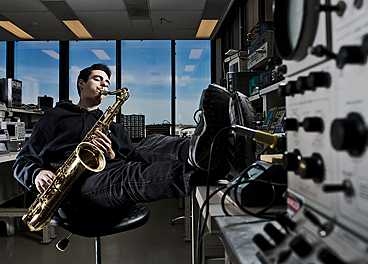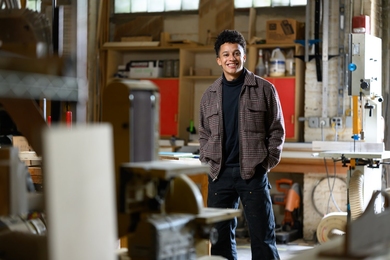Oh when the saints go marching in
Oh when the saints go marching in
Some play the song like that. But Dylan Sherry plays it like this:
Oh when the saints
Oh when the saints
Go marching in
Go marching in
Hear the difference?
“I like a Dixie-New Orleans style, because it’s exciting and a lot of interesting, unexpected things can occur,” says this 21-year-old tenor saxophonist. When Dylan was a baby, his father, a jazz bass player, lulled him to sleep every night with the sounds of Count Basie, Duke Ellington and Dizzy Gillespie. “By the time I was nine, the sounds stopped sounding like a random jumble and began to really cohere,” says Sherry, who for years attended his father’s gigs and continued to listen every night to the music of the jazz greats.
Now a grad student in electrical engineering and computer science, Sherry, who graduated in 2012, is a four-year member of the MIT Jazz Ensemble, and six times won MIT music awards for outstanding achievement. Trained in the classical style, Sherry has performed with the MIT Symphony Orchestra, MIT Wind Ensemble, and during MIT’s 150th celebration, he performed an improvised solo before a crowd of 9,000. He also is a guest artist on Echoes of the Prophet, a commercial CD he made with Sam Sherry, his dad.
“I love jazz. It’s spontaneous, always different, can’t be easily defined, and there are endless possibilities,” says Sherry, who at MIT was an Emerson Scholar, a scholarship for private instruction for top students who each year perform before a live audience. If you’ve ever heard of the Beatles –– and if you like to feel good –– listen to a song from his recent performance.
Work in harmony
“I want to work in artificial intelligence but I’ll never give up music. I’m planning my career and my music career to work in harmony,” says Sherry, who currently feels jazzed about working with a group to develop a cloud-backed, massive-scale platform for evolutionary computation.
“There are similarities between music and artificial intelligence,” he says. “Music has a deep relationship with the human mind and that could inform the field. In artificial intelligence, there’s a branch of research directed at how people represent ideas and concepts in their minds. For musicians, many of the structures they create are sufficiently complex to require great intellect; being able to grasp and understand such structures is a skill of the human mind and is probably the same one that allows computer scientists to manipulate software objects mentally or allows engineers to shuffle parts of designs around in their heads. I think there’s a great parallel there.”
MIT’s music program was a “gigantic factor” in Sherry’s decision to come to MIT and not to go to a music school, he says. “Conservatory programs are transforming musically, but MIT is transforming personally, professionally and also musically. No other science and engineering school is like it. Real music is happening here.”
Oh when the saints go marching in
Some play the song like that. But Dylan Sherry plays it like this:
Oh when the saints
Oh when the saints
Go marching in
Go marching in
Hear the difference?
“I like a Dixie-New Orleans style, because it’s exciting and a lot of interesting, unexpected things can occur,” says this 21-year-old tenor saxophonist. When Dylan was a baby, his father, a jazz bass player, lulled him to sleep every night with the sounds of Count Basie, Duke Ellington and Dizzy Gillespie. “By the time I was nine, the sounds stopped sounding like a random jumble and began to really cohere,” says Sherry, who for years attended his father’s gigs and continued to listen every night to the music of the jazz greats.
Now a grad student in electrical engineering and computer science, Sherry, who graduated in 2012, is a four-year member of the MIT Jazz Ensemble, and six times won MIT music awards for outstanding achievement. Trained in the classical style, Sherry has performed with the MIT Symphony Orchestra, MIT Wind Ensemble, and during MIT’s 150th celebration, he performed an improvised solo before a crowd of 9,000. He also is a guest artist on Echoes of the Prophet, a commercial CD he made with Sam Sherry, his dad.
“I love jazz. It’s spontaneous, always different, can’t be easily defined, and there are endless possibilities,” says Sherry, who at MIT was an Emerson Scholar, a scholarship for private instruction for top students who each year perform before a live audience. If you’ve ever heard of the Beatles –– and if you like to feel good –– listen to a song from his recent performance.
Work in harmony
“I want to work in artificial intelligence but I’ll never give up music. I’m planning my career and my music career to work in harmony,” says Sherry, who currently feels jazzed about working with a group to develop a cloud-backed, massive-scale platform for evolutionary computation.
“There are similarities between music and artificial intelligence,” he says. “Music has a deep relationship with the human mind and that could inform the field. In artificial intelligence, there’s a branch of research directed at how people represent ideas and concepts in their minds. For musicians, many of the structures they create are sufficiently complex to require great intellect; being able to grasp and understand such structures is a skill of the human mind and is probably the same one that allows computer scientists to manipulate software objects mentally or allows engineers to shuffle parts of designs around in their heads. I think there’s a great parallel there.”
MIT’s music program was a “gigantic factor” in Sherry’s decision to come to MIT and not to go to a music school, he says. “Conservatory programs are transforming musically, but MIT is transforming personally, professionally and also musically. No other science and engineering school is like it. Real music is happening here.”






